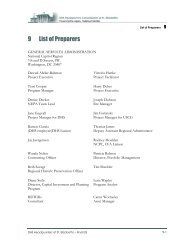395 - GSA Development of St. Elizabeths Campus
395 - GSA Development of St. Elizabeths Campus
395 - GSA Development of St. Elizabeths Campus
- No tags were found...
Create successful ePaper yourself
Turn your PDF publications into a flip-book with our unique Google optimized e-Paper software.
• Travel times along principal arterials are severely degraded, resulting in spill-over trafficon secondary arterials and local roadways. For example, Martin Luther King Jr. Avenueand South Capitol <strong>St</strong>reet assume additional traffic volumes from vehicles exiting I-295 inorder to avoid recurring congestion.• Most signalized intersections within the <strong>St</strong>udy Area are congested during the AM andPM peak periods. In some cases, especially along Firth <strong>St</strong>erling Avenue, SuitlandParkway, and Martin Luther King Jr. Avenue, queuing spills back from one intersectionto the next, resulting in a stream <strong>of</strong> continuous delays along major local corridors. It iscommon for queued traffic to wait two or more cycles at major traffic signals beforeclearing an intersection. The resulting traffic congestion reduces the accessibility <strong>of</strong> localside streets because it increases the difficulty <strong>of</strong> turning movements to and from arterialroadways.• Pedestrian traffic is heavily concentrated along Martin Luther King Jr. Avenue, HowardRoad, and Sumner Road. In the northern end <strong>of</strong> the <strong>St</strong>udy Area, the high occurrence <strong>of</strong>foot traffic is largely due to the Anacostia Metro <strong>St</strong>ation, the 11 th <strong>St</strong>reet Bridges, andsurrounding land use.2.2.2 Causes <strong>of</strong> CongestionCongestion within the <strong>St</strong>udy Area is due to several factors, including the limited capacity <strong>of</strong>arterials, the lack <strong>of</strong> continuous parallel routes on the north and east portions <strong>of</strong> the <strong>St</strong>udy Areaas well as connections between these routes, a highly unbalanced modal split in favor <strong>of</strong>automobiles, and the competing vehicular and modal demands at intersections. Several designdeficiencies within the <strong>St</strong>udy Area also contribute to congested conditions, such as intersectionswith tight turning radii, locations with bottlenecks or cut-through traffic. Highlights <strong>of</strong> the mostprominent congestion areas are summarized below:• Because Suitland Parkway is the only major east-west principal arterial in Southeast DC,its operational characteristics are characterized by through volumes that achieve orexceed the capacity <strong>of</strong> the facility, as well as extensive queues and delays at two at-gradeintersections within Ward 8: Firth <strong>St</strong>erling Avenue and <strong>St</strong>anton Road.‣ The intersection at Suitland Parkway and Firth <strong>St</strong>erling Avenue is one <strong>of</strong> themost congested locations within the <strong>St</strong>udy Area. This intersection’s proximity tothe Anacostia Metro <strong>St</strong>ation East Entrance and Metrobus transfer hub results in ahigh occurrence <strong>of</strong> buses and other transit vehicles through the intersection, aswell as a comparatively high incidence <strong>of</strong> pedestrian traffic than otherintersections in the <strong>St</strong>udy Area. In addition, Firth <strong>St</strong>erling Avenue is frequentlycongested because <strong>of</strong> its function as a primary linkage between local and regionaltransportation networks; it provides the principal connection between the BarryFarm neighborhood and the Anacostia Metro <strong>St</strong>ation, and transitions into thenorthbound on-ramp to I-295 just north <strong>of</strong> the Suitland Parkway Interchange.Thus the competing demands exceed the available capacity.‣ The intersection <strong>of</strong> Suitland Parkway with <strong>St</strong>anton Road represents one <strong>of</strong> thefirst major interruptions to free-flow speed inside the District, resulting insaturated traffic flow conditions at the traffic signal. This intersection contributesto long queues and delays because <strong>of</strong> the sheer volume <strong>of</strong> through traffic2-3
















